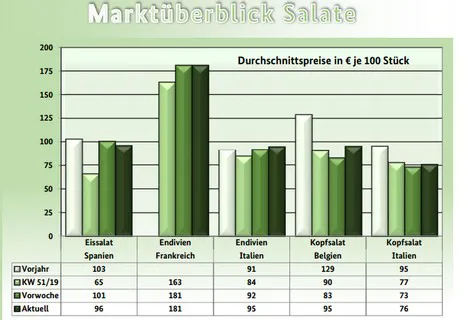Lettuce came from Belgium and Italy. The supply had been all in all limited. Sometimes this meant it was not possible to cover the demand completely. In some cases, Italian shipments were missing as well. The Belgian products were of a good quality and this made them quite popular. The traders often raised their prices because of this. Although the availability of Spanish iceberg lettuce had generally increased, it was not always sufficient to satisfy the friendly demand. The prices mostly climbed upwards, but this slowed down the turnover of goods.
In Munich, a wide price range was established as a result of inconsistent quality. Only Frankfurt reported discounts. For coloured lettuces, it was mainly the Italian batches that became cheaper, while the prices of the French goods remained constant. The batches from France were often free of defects and were well-received. For domestic lamb's lettuce, the distributors had to reduce their prices a little bit in Munich, because the supply was too extensive. Endives from Italy generated increased demand in Cologne and Munich towards the weekend. In Munich they then became more expensive.

Apples
Business was unexciting and without any particular highlights. As usual at this time of the season, domestic Jonagold, Boskoop and Elstar still dominated the market.
Pears
Italian Abate Fetel, Santa Maria and Williams Christ were prevailing. The market was really showing its calmer side. Relatively little changes were seen with regard to the prices.
Table grapes
South African deliveries apparently dominated the scene. The supply side had expanded. This meant that demand could be satisfied without any difficulty.
Oranges
Spanish Navelina dominated the blonde orange sector. From Spain there were also coming in Salustiana, Navelate, Navel and first Lane Late. The presence of the Egyptian navelina grew.
Small citrus fruits
Israeli orri can now be found in all markets. They had some prime organoleptic characteristics, which definitely accelerated their sales.
Lemons
Spanish Primofiori dominated the scene, more so than Turkish Enterdonato. Sales took place without any special incidents. The prices changed only here and there.
Bananas
The assessment of the market situation seemed to diverge. For one thing, demand was not too bad overall. On the other hand, the low temperatures apparently slowed down demand in the markets.
Cauliflower
Italian, French, Spanish and Belgian batches could be accessed. However, the prime quality goods were quite scarce in certain areas. The prices tended to move upwards.
Cucumbers
In the case of cucumbers, the influx from Spain was limited, meaning that supplies were tapering off. The prices rose as a result of this. This, however, hindered sales.
Tomatoes
Primarily it was Spanish, Dutch, Moroccan and Belgian batches that were accessible. There was a fairly calm market atmosphere. At times, prices tended to move upwards as availability was limited.
Sweet peppers
Spanish offers dominated events here, more so than Turkish and Moroccan offers. Marketing was uneven. In Hamburg, for example, yellow Spanish cultivars became more expensive due to their limited supply.
Source: BLE
